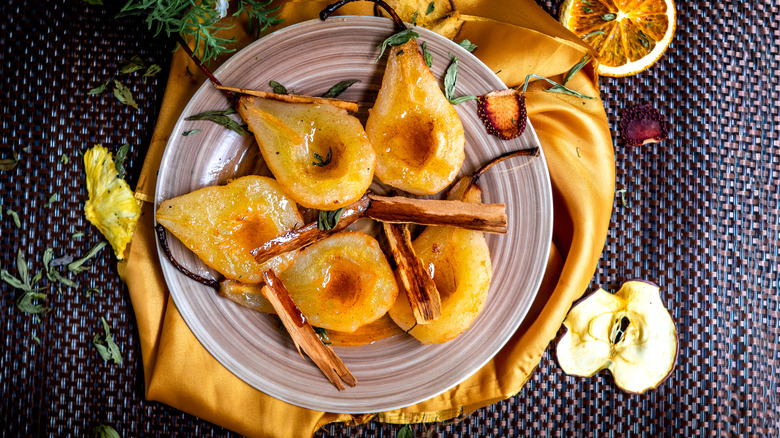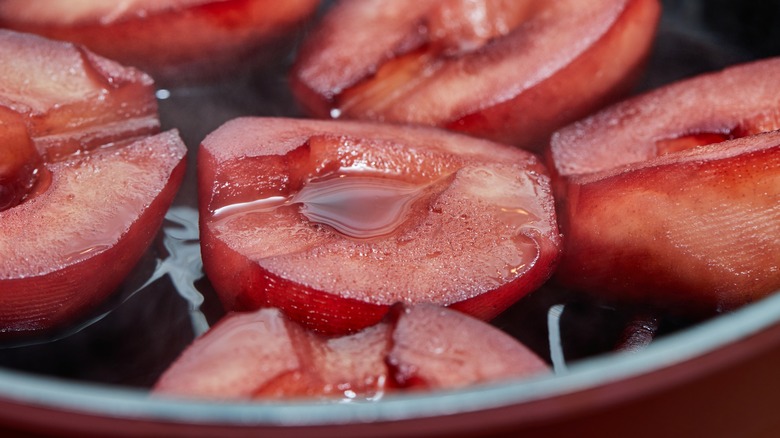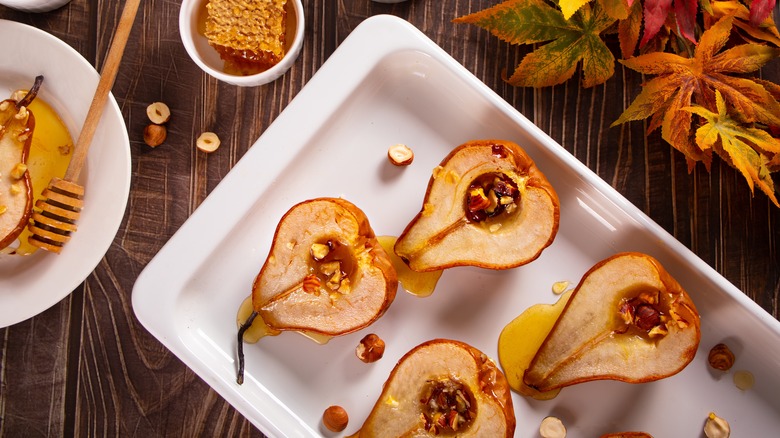Poached Pears Vs. Baked: What's The Difference?
Pears often get overlooked, but they're the perfect fruit to sink your teeth into during the fall and winter months. They can be a little hard and sour if they're not ripe, but there's nothing better than a ripe pear — sweet, soft, and succulent, the right one will leave its juices dripping down your chin.
Due to their tender texture, pears used to be called "butter fruits" back in the day. Yet as soft as they are by themselves, they get even sweeter and juicier once you cook them. You could mix them into a classic fruit dessert like a pear almond tart, where they get sliced and placed on top of a creamy almond filling. But pears don't need to be overshadowed by many other ingredients — just like peaches, they thrive when cooked with a bit of butter, cinnamon, and brown sugar.
You can sauté, stew, or slow-cook pears, but two of the most popular ways to cook these fruits involve poaching or baking them. What are the differences between the two cooking methods?
Poached pears are typically peeled, cut in half, and then cooked in a customized liquid
Not only do poached pears taste delicious, but they look and smell heavenly too. If you've never tried making them, you're in for a real wintertime treat and only need a few ingredients. Pears are essential, of course, and they work well for poaching because they don't fall apart after hours on the stove. You can customize the liquid you use to poach them to fit your taste buds, although there are a few ingredients that are almost universally favored.
First, you'll need to peel your pears and either leave them whole or cut them in half and core them. Some recommend tossing the fruit in orange juice to prevent browning since they'll be exposed to the air while they cook. Then simply place the pears in a liquid of your choice and simmer for up to half an hour or until the pears get tender, at which point you can remove them and let the juice continue cooking until it thickens into a syrupy consistency.
You can make whatever kind of poaching liquid you'd like, but one cozy option includes red wine, honey, cinnamon, oranges, sugar, and cardamom — a hot, sangria-like bath for the pears if you will. If you're making this for kids or want to leave the alcohol out, swap the wine for water or fruit juice.
Baked pears can be cut into smaller pieces and are baked to caramelize
Baked pears are arguably even easier to make than poached pears, and they'll still fill your house with a warm, cinnamon aroma. They may require more prep time than poached pears, as they're typically cored and halved before baking or cut into even smaller pieces. But once that's complete, baked pears are pretty hands-off.
Like with poached pears, they generally cook in a liquid of your choice, although wine is often swapped out in favor of simpler ingredients like butter, brown sugar, cinnamon, nutmeg, and vanilla. Nuts like pecans and walnuts are often thrown in the mix, along with honey and cheeses like gorgonzola, blue cheese, or goat cheese. You can sprinkle your toppings in the middle of the pears before baking or add them at the end as a delicious garnish.
Once you've nailed down your ingredients, baked pears go in the oven for up to half an hour or until they're tender. While the method and mix-ins for poached and baked pears can differ quite a bit, they're often served in similar ways — with vanilla ice cream, whipped cream, cheese, or more of their juices.


